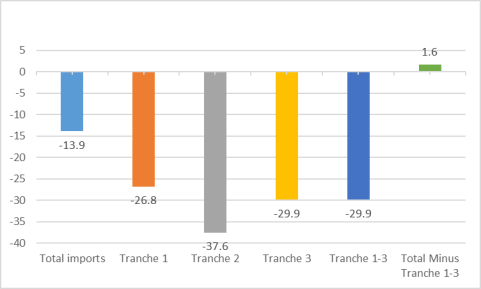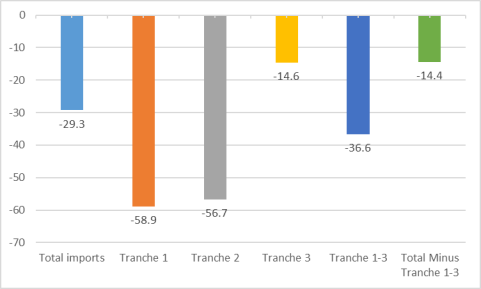Figure 1. U.S. Imports from China of Products Affected by U.S. Section 301 Tariff Hikes
(January-March 2019 Year-on-Year (% Change))

Source: USITC Dataweb.
Commercial relations between the United States and China are experiencing an increasing level of tension and uncertainty. In August 2017, the Trump Administration launched a Section 301 investigation of Chinese policies relating to technology transfer, intellectual property, and innovation policies deemed harmful to U.S. economic interests. In March 2018, the Administration announced it would take specified action against China in response to such policies, including increased tariffs. The Administration subsequently raised tariffs on three tranches of import products from China, (with estimated combined worth of $250 billion). China imposed retaliatory tariff increase on three tranches of imported products from the United States (with estimated combined worth of $110 billion).
On February 14, 2019, President Trump tweeted that trade negotiations with China were in "advanced stages" and suggested that an agreement could soon be reached. However, on May 5, he tweeted that trade negotiations were going "too slowly" and that China was attempting to "renegotiate" previous trade commitments. As a result, on May 10, he ordered that tariffs on a third tranche of Chinese goods be raised from 10% to 25% (made fully effective on June 15) and that the process for increasing tariffs by 25% on nearly all remaining U.S. imports from China (estimated value at $300 billion) be started. On May 13, China announced it would increase its tariffs on many of the U.S. products listed in its third tranche (effective June 1). China blamed the United States for the breakdown in talks, claiming it had "persisted with exorbitant demands" and demanded concessions touching on "China's sovereign affairs."
Both sides are experiencing trade impacts of the tariff hikes. While U.S. merchandise imports from China in 2018 rose by 6.7% (to $540 billion), over the previous year (data not shown), they fell by 13.9% during the first quarter of 2019 year-over-year, while imports covered by U.S. tariff hikes dropped by 29.9% (see Figure 1). Similarly, while Chinese imports from the United States increased by 2.4% (to $154 billion) in 2018 (data not shown), they fell by 29.3% during the first quarter of 2019. Imports of U.S. products covered under China's retaliatory tariff measures fell 36.6% (year-over-year). (See Figure 2.) This has raised concerns that China is increasingly turning to non-U.S. suppliers who are not subject to the higher tariffs.
|
Figure 1. U.S. Imports from China of Products Affected by U.S. Section 301 Tariff Hikes (January-March 2019 Year-on-Year (% Change)) |
 |
|
Source: USITC Dataweb. |
|
Figure 2. Chinese Imports of U.S. Products Affected by Retaliatory Chinese Tariff Hikes (January-March 2019 Year-on-Year (% Change)) |
 |
|
Source: USITC Dataweb. |
In addition to tariff increases, the United States and China have implemented other measures (or have threatened to take certain actions) that could lead to additional restrictions on bilateral commercial ties and greater uncertainty in the bilateral economic relationship
Some economists have raised concerns that the current U.S.-China trade conflict (if not resolved soon) could eventually hit nearly all bilateral trade with increased tariff hikes, lead to additional types and rounds of commercial retaliatory measures, and possibly result in "economic decoupling."